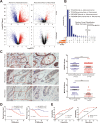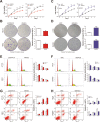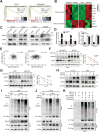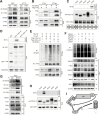E3 ubiquitin ligase MAGI3 degrades c-Myc and acts as a predictor for chemotherapy response in colorectal cancer
- PMID: 35864508
- PMCID: PMC9306183
- DOI: 10.1186/s12943-022-01622-9
E3 ubiquitin ligase MAGI3 degrades c-Myc and acts as a predictor for chemotherapy response in colorectal cancer
Abstract
Background: Recurrence and chemoresistance constitute the leading cause of death in colorectal cancer (CRC). Thus, it is of great significance to clarify the underlying mechanisms and identify predictors for tailoring adjuvant chemotherapy to improve the outcome of CRC.
Methods: By screening differentially expressed genes (DEGs), constructing random forest classification and ranking the importance of DEGs, we identified membrane associated guanylate kinase, WW and PDZ domain containing 3 (MAGI3) as an important gene in CRC recurrence. Immunohistochemical and western blot assays were employed to further detect MAGI3 expression in CRC tissues and cell lines. Cell counting kit-8, plate colony formation, flow cytometry, sub-cutaneous injection and azoxymethane plus dextran sulfate sodium induced mice CRC assays were employed to explore the effects of MAGI3 on proliferation, growth, cell cycle, apoptosis, xenograft formation and chemotherapy resistance of CRC. The underlying molecular mechanisms were further investigated through gene set enrichment analysis, quantitative real-time PCR, western blot, co-immunoprecipitation, ubiquitination, GST fusion protein pull-down and immunohistochemical staining assays.
Results: Our results showed that dysregulated low level of MAGI3 was correlated with recurrence and poor prognosis of CRC. MAGI3 was identified as a novel substrate-binding subunit of SKP1-Cullin E3 ligase to recognize c-Myc, and process c-Myc ubiquitination and degradation. Expression of MAGI3 in CRC cells inhibited cell growth, promoted apoptosis and chemosensitivity to fluoropyrimidine-based chemotherapy by suppressing activation of c-Myc in vitro and in vivo. In clinic, the stage II/III CRC patients with MAGI3-high had a significantly good recurrence-free survival (~ 80%, 5-year), and were not necessary for further adjuvant chemotherapy. The patients with MAGI3-medium had a robustly good response rate or recurrence-free survival with fluoropyrimidine-based chemotherapy, and were recommended to undergo fluoropyrimidine-based adjuvant chemotherapy.
Conclusions: MAGI3 is a novel E3 ubiquitin ligase by degradation of c-Myc to regulate CRC development and may act as a potential predictor of adjuvant chemotherapy for CRC patients.
Keywords: Colorectal cancer; Fluoropyrimidine-based systemic chemotherapy; MAGI3; PDZ; Recurrence; c-Myc.
© 2022. The Author(s).
Conflict of interest statement
The authors have declared that no competing interest exists.
Figures







Similar articles
-
E3 Ubiquitination Ligase MYLIP Mediates the NKRF/SLC25A34 Axis to Suppress Malignant Progression in Colorectal Cancer.Dig Dis Sci. 2025 Feb;70(2):581-597. doi: 10.1007/s10620-024-08735-9. Epub 2024 Dec 11. Dig Dis Sci. 2025. PMID: 39661280
-
CAFs secreted exosomes promote metastasis and chemotherapy resistance by enhancing cell stemness and epithelial-mesenchymal transition in colorectal cancer.Mol Cancer. 2019 May 7;18(1):91. doi: 10.1186/s12943-019-1019-x. Mol Cancer. 2019. PMID: 31064356 Free PMC article.
-
HERC3 directly targets RPL23A for ubiquitination degradation and further regulates Colorectal Cancer proliferation and the cell cycle.Int J Biol Sci. 2022 May 1;18(8):3282-3297. doi: 10.7150/ijbs.72014. eCollection 2022. Int J Biol Sci. 2022. PMID: 35637966 Free PMC article.
-
Functional significance and therapeutic implication of ring-type E3 ligases in colorectal cancer.Oncogene. 2018 Jan 11;37(2):148-159. doi: 10.1038/onc.2017.313. Epub 2017 Sep 18. Oncogene. 2018. PMID: 28925398 Free PMC article. Review.
-
Significant position of C-myc in colorectal cancer: a promising therapeutic target.Clin Transl Oncol. 2022 Dec;24(12):2295-2304. doi: 10.1007/s12094-022-02910-y. Epub 2022 Aug 16. Clin Transl Oncol. 2022. PMID: 35972682 Review.
Cited by
-
The involvement of E3 ubiquitin ligases in the development and progression of colorectal cancer.Cell Death Discov. 2023 Dec 16;9(1):458. doi: 10.1038/s41420-023-01760-z. Cell Death Discov. 2023. PMID: 38104139 Free PMC article. Review.
-
Circaea mollis Siebold & Zucc. Induces Apoptosis in Colorectal Cancer Cells by Inhibiting c-Myc Through the Mediation of RPL5.Int J Mol Sci. 2025 May 13;26(10):4664. doi: 10.3390/ijms26104664. Int J Mol Sci. 2025. PMID: 40429805 Free PMC article.
-
Advances of E3 ligases in lung cancer.Biochem Biophys Rep. 2024 May 27;38:101740. doi: 10.1016/j.bbrep.2024.101740. eCollection 2024 Jul. Biochem Biophys Rep. 2024. PMID: 38841185 Free PMC article. Review.
-
Reciprocal interactions between lncRNAs and MYC in colorectal cancer: partners in crime.Cell Death Dis. 2024 Jul 29;15(7):539. doi: 10.1038/s41419-024-06918-w. Cell Death Dis. 2024. PMID: 39075086 Free PMC article. Review.
-
Upregulation of FAM83F by c-Myc promotes cervical cancer growth and aerobic glycolysis via Wnt/β-catenin signaling activation.Cell Death Dis. 2023 Dec 16;14(12):837. doi: 10.1038/s41419-023-06377-9. Cell Death Dis. 2023. PMID: 38104106 Free PMC article.
References
-
- Bray F, Ferlay J, Soerjomataram I, Siegel RL, Torre LA, Jemal A. Global cancer statistics 2018: GLOBOCAN estimates of incidence and mortality worldwide for 36 cancers in 185 countries. CA Cancer J Clin. 2018;68:394–424. - PubMed
-
- Al BBI, Schrag D, Somerfield MR, Cohen AM, Figueredo AT, Flynn PJ, Krzyzanowska MK, Maroun J, McAllister P, Cutsem EV, et al. American society of clinical oncology recommendations on adjuvant chemotherapy for stage ii colon cancer. J Clin Oncol. 2004;22:3408–3419. doi: 10.1200/JCO.2004.05.063. - DOI - PubMed
Publication types
MeSH terms
Substances
LinkOut - more resources
Full Text Sources
Medical
Molecular Biology Databases
Research Materials

